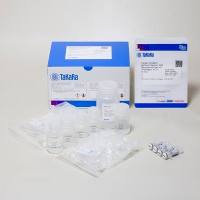Fluorescence In Situ Hybridization and Comparative Genomic Hybridization
互联网
690
This chapter discusses the complementary methodologies of fluorescence in situ hybridization and comparative genomic hybridization. Fluorescence in situ hybridization uses fluorescently labeled DNA probes (whole chromosomes, centromere, or locus-specific sequences) to visualize complementary DNA sequences in the target DNA (metaphase chromosomes or interphase nuclei). Comparative genomic hybridization is essentially a modified in situ hybridization, whereby the whole genome can be screened for gains and losses in a single experiment. Tumor and normal DNA are differentially fluorescently labeled and competitively co-hybridized to normal metaphase spreads. Both techniques require multiple steps in their preparation. These can be divided into preparation of the target, preparation of the probes, hybridization, post-hybridization washes, and image acquisition and analysis, each of which will be described in detail. Success of each experiment is dependent on all of these steps, but where steps are of critical importance to particular techniques, they will be highlighted, together with notes on how to optimize the process.









